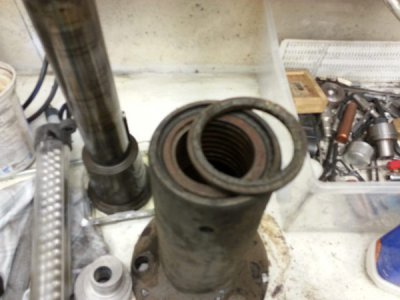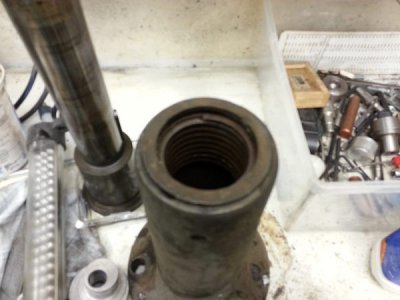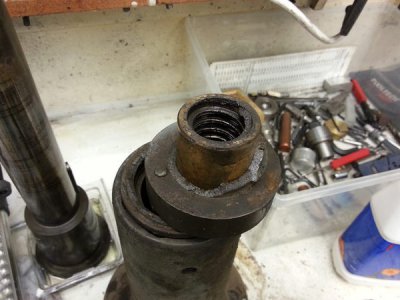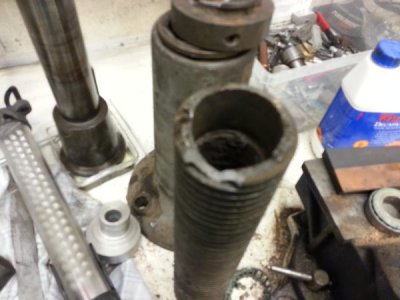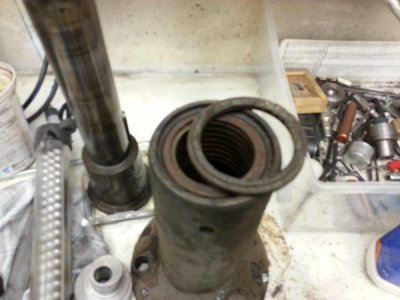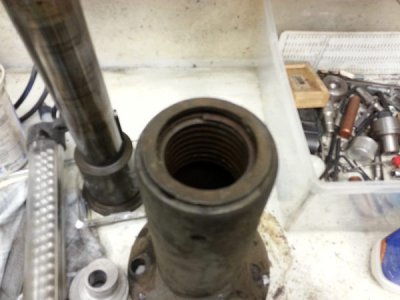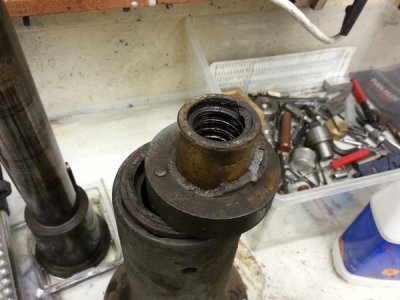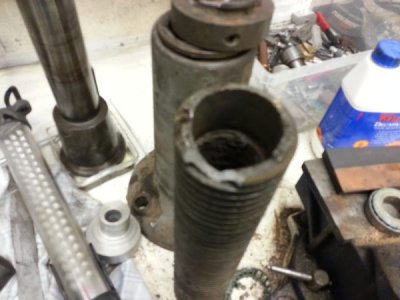- Joined
- Aug 15, 2014
- Messages
- 75
http://imgur.com/a/V2lkl
Here's an album of the functional restoration of this Denbigh milling machine I've found. I found it in a welding shop in Alberta, crammed at the back. The owner said he used it once a year to cut a keyway, and the guy before him the same. The first owner appears to have painted the sliding precision surfaces, which sounds dumb but it worked in my favour. I have no idea how old it is, I can't find it on lathes.co.uk, but I at least know that because it's got the 3-3/8 overarm it's before 1956. It looks like it was designed to run with an over head shaft setup, but someone modified it to run with an electric motor. Everything seems well oiled, the dust had gathered and made some kind of paste that seems to have prevented rust on the shafts and exposed surfaces. None of the fasteners are seized or rounded off, an experienced wrench maintained it. I think it was well maintained and nearly unused. The oil holes were plugged with that oily crud, so I'm glad I fully pulled it apart to clean it well. I'm also using paint stripper to try to get that paint off the ways without harming the surface. I hope the guy didn't prep with sand paper, but it looks ok so far. Because of the paint I haven't been able to evaluate wear on the ways. There is a crack on the casting on the rear over arm clamp bolt. It's probably going to prevent tightening up that end. I don't know what I'm going to do about that just yet. I might just ignore it since I'm probably not going to be using it to it's full capacity that way anyway. Maybe drilling and tapping the end so I can bolt an external clamp ring to it.
The back gear has a funny arrangement (to me). The big gear at the front is keyed to the spindle and has a bolt. You loosen the bolt and slide it inwards and tighten it again, and that frees it from the step pulleys. Then you unlock and throw the lever to the right, which turns an eccentric and pushes the back gear shaft towards the spindle and engages the spindle gears. A bit of a dance, but the major benefit to me is it's an extremely simple and resilient mechanism.
The vertical attachment is NMTB40 (yay!) and not the same make as the machine, and probably a lot newer, but is 1:1 ratio unfortunately. I was hoping it spun faster. I haven't figured out the RPM ranges yet as I haven't powered it up yet, but I don't expect it to be much. I ran the math on the front bronze bearing and it looks like it's capable of running 1000 rpm with at least 500lb load before it starts to exceed the PV ratings for the lowest performing bronze I could find, so I think I could probably play with motor pulleys to get some speed out of it if I arrange a drip oiler or something. There doesn't seem to be any wear at all on the spindle bearings. Not a whole lot of vertical room between the table and the vertical attachment, but it sure beats milling on my lathe, and I can always use an angle plate. It came with an MT4 adapter that screws onto the horizontal spindle, so I can use my MT4 collet set!
The table swivels, which was super handy for removing about 250 lbs of weight to make it easier to get off the truck. Remove the two clamp bolts, pull straight up.
So, a few questions. Has anyone seen this model? Any information about it? What oil is typically used on a tapered bronze spindle bearing? The oil holes are just holes drilled into the bearing from the outside of the casting, looks like half a pencil sized hole. The inner surface of the bearing has an oil grove to distribute it. How often should you be adding oil while you work? Is there a SFPM rule of thumb for flat belts?
Here's an album of the functional restoration of this Denbigh milling machine I've found. I found it in a welding shop in Alberta, crammed at the back. The owner said he used it once a year to cut a keyway, and the guy before him the same. The first owner appears to have painted the sliding precision surfaces, which sounds dumb but it worked in my favour. I have no idea how old it is, I can't find it on lathes.co.uk, but I at least know that because it's got the 3-3/8 overarm it's before 1956. It looks like it was designed to run with an over head shaft setup, but someone modified it to run with an electric motor. Everything seems well oiled, the dust had gathered and made some kind of paste that seems to have prevented rust on the shafts and exposed surfaces. None of the fasteners are seized or rounded off, an experienced wrench maintained it. I think it was well maintained and nearly unused. The oil holes were plugged with that oily crud, so I'm glad I fully pulled it apart to clean it well. I'm also using paint stripper to try to get that paint off the ways without harming the surface. I hope the guy didn't prep with sand paper, but it looks ok so far. Because of the paint I haven't been able to evaluate wear on the ways. There is a crack on the casting on the rear over arm clamp bolt. It's probably going to prevent tightening up that end. I don't know what I'm going to do about that just yet. I might just ignore it since I'm probably not going to be using it to it's full capacity that way anyway. Maybe drilling and tapping the end so I can bolt an external clamp ring to it.
The back gear has a funny arrangement (to me). The big gear at the front is keyed to the spindle and has a bolt. You loosen the bolt and slide it inwards and tighten it again, and that frees it from the step pulleys. Then you unlock and throw the lever to the right, which turns an eccentric and pushes the back gear shaft towards the spindle and engages the spindle gears. A bit of a dance, but the major benefit to me is it's an extremely simple and resilient mechanism.
The vertical attachment is NMTB40 (yay!) and not the same make as the machine, and probably a lot newer, but is 1:1 ratio unfortunately. I was hoping it spun faster. I haven't figured out the RPM ranges yet as I haven't powered it up yet, but I don't expect it to be much. I ran the math on the front bronze bearing and it looks like it's capable of running 1000 rpm with at least 500lb load before it starts to exceed the PV ratings for the lowest performing bronze I could find, so I think I could probably play with motor pulleys to get some speed out of it if I arrange a drip oiler or something. There doesn't seem to be any wear at all on the spindle bearings. Not a whole lot of vertical room between the table and the vertical attachment, but it sure beats milling on my lathe, and I can always use an angle plate. It came with an MT4 adapter that screws onto the horizontal spindle, so I can use my MT4 collet set!
The table swivels, which was super handy for removing about 250 lbs of weight to make it easier to get off the truck. Remove the two clamp bolts, pull straight up.
So, a few questions. Has anyone seen this model? Any information about it? What oil is typically used on a tapered bronze spindle bearing? The oil holes are just holes drilled into the bearing from the outside of the casting, looks like half a pencil sized hole. The inner surface of the bearing has an oil grove to distribute it. How often should you be adding oil while you work? Is there a SFPM rule of thumb for flat belts?
Last edited:

